Photo

A new snapshot from https://sagesacre.com/2022/07/06/cashflow-zucchini-is-a-winner/
Cashflow Zucchini is a Winner
In a vegetable garden that’s been kind of a disappointment, this zucchini squash is a real standout
Cashflow zucchini with fruit on the plant in July 2022
Record heat, record cold, drought, rampaging ground squirrels — halfway through 2022, and the vegetable garden has been, at best, a mixed bag.
One bright spot is this Zucchini, Cashflow. Not only is the plant relatively compact, but it also grows upright, almost like a tree. What’s more, unlike other types of zukes, if you don’t pick the fruit right away (which I rarely do), they don’t keep growing until they’re the size of baseball bats. Rather they top out at 8 to 9-inches and the plant goes on to flower again.
Over the past couple of weeks I’ve pulled a dozen smooth and symmetrical zucchinis off of it, and it doesn’t look like it’s even getting close to calling it quits. There’s already four new fruit and a fifth one flowering now.
Definitely a really productive, low maintenance vegetable. I highly recommend it.
(Oh, and did I mention the seed was from 2012?)
0 notes
Photo

A new snapshot from https://sagesacre.com/2022/06/03/remembering-less-squirrely-times/
Remembering Less Squirrely Times

This year I’m overrun by ground squirrels, but there was a time when they weren’t a problem
youtube
youtube
(Tip — the video has a surprise ending.)
The number of ground squirrels overrunning The Acre this year is astounding.
I don’t know if the dry winter let more survive, or if my neighbor’s newly constructed pool drove them out, or if all the good squirrel predators have changed their tastes, but I am literally stumbling over these rodents and their burrows everywhere.
I’ve found them wreaking havoc in the vegetable garden, the keyhole garden, and the greenhouse. This morning there was one chowing down on a cherimoya on my back deck. Since March I’ve trapped more than 40, and spent ungodly amounts on baits, poisons and gasses – all to little or no effect as far as I can tell.
It wasn’t always like this though.
Once upon a time we had four Dachshunds. Low slung wienerdogs with shovels for front paws and a single-minded determination to dig as far and fast as they could in pursuit of burrowing animals.
They were a quartet of rescues, all abandoned because they were the undesirable “tweenie” size, weren’t perfectly shaped for the breed, or had health problems like Cushing’s disease, bad backs, etc.
Individually they were plenty of fun, but together they were a pack of baying, barking hyperactive hounds that tore up landscaping and irrigation, and turned significant portions of the yard into a crater-filled moonscape in pursuit of gophers, moles and, most importantly, ground squirrels.
To my best recollection, they never caught more than one or two squirrels, but their sheer determination and persistence at chasing those rodents in their tunnels seemed to be enough to keep all but the most foolish squirrels far away.
The other day I got a comment on a video I posted years ago of three members of the weenie pack (Rommel, Franzi and Monty) working a burrow down on the slope of the dry creek. I had forgotten about the video, so when I clicked through to it, I was surprised to find that it had over a million views!
Three of the four have since passed, so only Hank remains. He’s of the age where prefers a good nap in the sun to a long dig. The other three are now all resting along the slope of the dry creek where the video was shot.
Interestingly, while the hill is riddled with squirrel burrows, there are none where the doxies now lie, which makes me feel as if they’re still doing their job – just without the torn up sprinklers and trenches.
Good dogs in less squirrely times.
.fusion-body .fusion-builder-column-0width:100% !important;margin-top : 0px;margin-bottom : 20px;.fusion-builder-column-0 > .fusion-column-wrapper padding-top : 0px !important;padding-right : 0px !important;margin-right : 1.92%;padding-bottom : 0px !important;padding-left : 0px !important;margin-left : 1.92%;@media only screen and (max-width:1024px) .fusion-body .fusion-builder-column-0width:100% !important;order : 0;.fusion-builder-column-0 > .fusion-column-wrapper margin-right : 1.92%;margin-left : 1.92%;@media only screen and (max-width:640px) .fusion-body .fusion-builder-column-0width:100% !important;order : 0;.fusion-builder-column-0 > .fusion-column-wrapper margin-right : 1.92%;margin-left : 1.92%;
.fusion-body .fusion-flex-container.fusion-builder-row-1 padding-top : 0px;margin-top : 0px;padding-right : 0px;padding-bottom : 0px;margin-bottom : 0px;padding-left : 0px;
#dachshund#ground squirrel#ground squirrel control#natural pest control#san diego garden#weinerdog#zone9garden
2 notes
·
View notes
Photo

A new snapshot from https://sagesacre.com/2022/05/22/gaucho-the-immortal/
Gaucho the Immortal
This little bantam rooster turned 14 back in March. He looks even more magnificent today.
Gaucho at age 14 looks amazing
Me n’ Gaucho have been friends a long time — More than 14 years to be exact.
As a señor citizen, his spurs are long so he walks funny, and he’s not as active as he once was, but I still find him in remote corners of the yard scratching around and doing important rooster stuff.
Gaucho raking a garden bed for me
He’s also the only chicken that regularly follows me around. He “worked” with me to turn a raised bed in the vegetable garden the other day.
This morning morning he wandered the yard with me as we changed out the feeders and water for the rest of the poultry. Then we had brunch down by the shed. I had coffee and a muffin, Gaucho enjoyed some scratch tossed on the ground just the way he likes it.
His plumage in the late spring morning sun looks resplendent. Hard to believe he’s closing in on the record for world’s oldest chicken.
Give us crow, Gaucho
youtube
youtube
.fusion-body .fusion-builder-column-0width:100% !important;margin-top : 0px;margin-bottom : 0px;.fusion-builder-column-0 > .fusion-column-wrapper padding-top : 0px !important;padding-right : 0px !important;margin-right : 1.92%;padding-bottom : 0px !important;padding-left : 0px !important;margin-left : 1.92%;@media only screen and (max-width:1024px) .fusion-body .fusion-builder-column-0width:100% !important;.fusion-builder-column-0 > .fusion-column-wrapper margin-right : 1.92%;margin-left : 1.92%;@media only screen and (max-width:640px) .fusion-body .fusion-builder-column-0width:100% !important;.fusion-builder-column-0 > .fusion-column-wrapper margin-right : 1.92%;margin-left : 1.92%;
.fusion-body .fusion-flex-container.fusion-builder-row-1 padding-top : 0px;margin-top : 0px;padding-right : 0px;padding-bottom : 0px;margin-bottom : 0px;padding-left : 0px;
#backyardflock#backyardchickens#backyardgardening#backyardpoultrymag#californiagarden#chickenlove#chickens#chickensofinstagram#fresheggs#gaucho#happychickens#happyhens#hens#mybackyard#sandiegogarden#zone9#zone9garden
0 notes
Photo
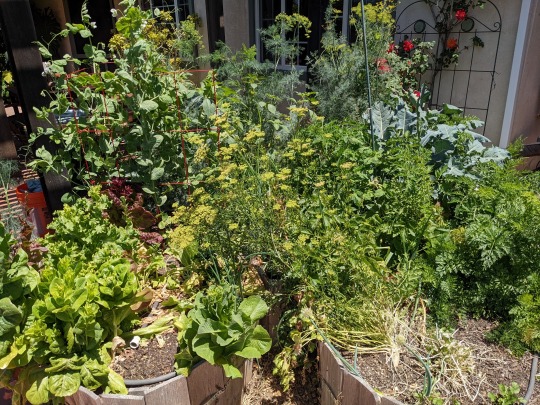
A new snapshot from https://sagesacre.com/2022/05/17/the-incredible-productivity-of-the-keyhole-garden/
The Incredible Productivity of the Keyhole Garden
I get almost 5 pounds of food per square foot from this simple, organic, and sustainable garden
Keyhole Garden in May 2022
My keyhole garden turned three years old a few weeks ago and it continues to amaze.
Aside from a few days halfway through its first year, it’s been in non-stop production the entire time. Baking heat, freezes, pouring rain, wind, it doesn’t matter, nothing stops this thing.
Right now the early spring crops – leaf lettuce, broccoli, carrots, peas, red and brown onions, dill, and parsley – are giving way to early summer crops – tomatoes, bunching onions, summer squash, basil and cilantro. It’s basically a whole food garden packed into one 8 foot circular bed.
If you’re not familiar with the keyhole garden concept, it’s a circular raised bed with a composting bin at the center. A notch, like a keyhole, is cut into the side of the bed to allow access to the compost bin. The bed’s height and shape provide good drainage and easy access from any angle, while the compost bin leaches nutrients back into the bed keeping the plants in it happy and well-fed.
Another advantage of the keyhole garden is one I wasn’t aware of when I first built it. It turns out the compost bin’s activity acts like a little organic radiator keeping the soil surrounding it quite warm even when the weather’s cold and ugly for an extended period.
A peek in the Keyhole Garden Compost Bin
youtube
youtube
In the late fall the plants’ roots dig into the warm soil and continue producing for a much longer time than would otherwise be possible. In my case, where it freezes overnight often enough but doesn’t snow, I’ve had bell peppers, tomatoes and basil growing alongside broccoli, carrots and onions all winter (I don’t even cover them).
In April of last year I estimated we harvested about 150 pounds of fresh herbs and vegetables a year in the first two years – roughly 1-½ pounds of food per square foot of keyhole garden.
Not too bad.
Later that spring I mastered a few tricks for “pie slice”, “high-low”, and succession planting (more on those later) that allowed the garden to more than triple its output, so we’re getting close to 4-½ pounds of fresh food per square foot. Oh, and all with no additional fertilizer or soil beyond what the compost bin provides.
Now that’s great!
Add in that it helps us reduce our food and green waste to near zero, and my total investment was less than $200, and you’ll understand why I think the keyhole garden is incredible.
If you’re considering your own garden and you want something that’s inexpensive, organic and sustainable, you definitely need to give the keyhole garden a try.
More Keyhole Garden Posts
.fusion-blog-shortcode-1 .fusion-blog-layout-grid .fusion-post-gridpadding:20px;.fusion-blog-shortcode-1 .fusion-posts-containermargin-left: -20px !important; margin-right:-20px !important;
Build a Keyhole Garden
Garden
Build a Keyhole Garden
Lessons from the Keyhole Garden
Garden, Projects
Lessons from the Keyhole Garden
The Keyhole Garden’s Second Anniversary
Garden, Photos
The Keyhole Garden’s Second Anniversary
12Next
.fusion-body .fusion-builder-column-0width:100% !important;margin-top : 0px;margin-bottom : 0px;.fusion-builder-column-0 > .fusion-column-wrapper padding-top : 0px !important;padding-right : 0px !important;margin-right : 1.92%;padding-bottom : 0px !important;padding-left : 0px !important;margin-left : 1.92%;@media only screen and (max-width:1024px) .fusion-body .fusion-builder-column-0width:100% !important;.fusion-builder-column-0 > .fusion-column-wrapper margin-right : 1.92%;margin-left : 1.92%;@media only screen and (max-width:640px) .fusion-body .fusion-builder-column-0width:100% !important;.fusion-builder-column-0 > .fusion-column-wrapper margin-right : 1.92%;margin-left : 1.92%;
.fusion-body .fusion-flex-container.fusion-builder-row-1 padding-top : 0px;margin-top : 0px;padding-right : 0px;padding-bottom : 0px;margin-bottom : 0px;padding-left : 0px;
#backyardgardening#californiagarden#compost#compostgonewild#eatwhatyougrow#ediblegarden#gardenersofinstagram#gardening#gardentotable#greenthumb#growfood#growwhatyoueat#growyourfood#growyourown#growyourownfood#gyo#keyholebuild#kitchengarden#mybackyard#organicgardening#raisedbedgarden#sandiegogarden#vegetablegarden#veggiegarden#zone9garden
0 notes
Photo

A new snapshot from https://sagesacre.com/2022/04/21/feijoa-blooms-again/
The Feijoa Blooms again

Feijoa (Pineapple Guava) only blooms on second year wood so after a hard pruning last year, the tree was just a big leafy green muppet looking thing.
Now that the weather is warming up again, however, the tree is blooming like there’s no tomorrow. The flowers don’t have much of a scent, but they are quite wonderful to look at. And, for whatever reason, the mockingbirds absolutely love them. Mid-mornings the tree is so full of those noisy squawkers it’s almost deafening.
Looks like this fall we’ll have a ton of fruit.
#feijoa#Feijoa sellowiana#guava#pineapple guava#rare fruit#san diego garden#tropical garden#zone 9 garden
0 notes
Photo

A new snapshot from https://sagesacre.com/2022/04/20/how-much-does-it-cost-to-raise-your-own-eggs/
How much does it cost to raise your own eggs?
Inflation suddenly makes having your own laying hens look financially smart
Eggs from the Hens
When people ask why I have chickens, I tell them the truth. I have chickens mostly for pest and weed control. I also find watching them do chicken stuff to be relaxing. Fresh eggs are just a side benefit.
Years ago, when most of the hens were young, we had so many eggs we gladly gave them away. “Leave an empty egg carton, get a full one in return,” was our motto.
Someone once asked me what a dozen eggs cost us to produce and I did a little math to come up with an estimate of around 11¢ each, $1.32 a dozen. At the time store eggs were only $1.50 a dozen, so it wasn’t a big savings. But they sure looked and tasted a lot better.
Most of the hens are older now and we don’t get eggs as reliably as we once did. A couple of weeks ago we had a cooking flurry, managed to run through all our own eggs, and had to go to the store for more.
Holy cow (or chicken).
Talk about sticker shock. Eggs are expensive now. I paid $5.50 for 18 plain old extra large eggs, which nets out to about 31¢ apiece!
Now, I live in California and I realize it has weird farm rules. Stuff like every laying hen gets her own air conditioned condo, yoga classes, free Netflix, etc., etc.
Chickens at the Gate
All of that raises costs. But 300%? Dang…
Turns out most of the recent price increases have nothing to do with the crazy California regulations and everything to do with the business of eggs costing more. From workers to feed and fuel, everything’s a lot more to produce, package and ship, and those costs are being reflected in the price.
That got me to thinking what my own costs are now.
Chicken feed prices have been rising for a while and 50 pound sack now costs $22, about 50% more than a year ago, so a trip to the feed store hits the wallet harder than it used to.
Fortunately my fowl are free-range and dig up a fair amount of food on their own, so they don’t eat as much feed as others might. I figure each of the eight hens eats about one pound of food a week and produces two to three eggs (they slow down when they’re older), so I get around 18 eggs for around $3.50 in feed, which is 20¢ each.
That’s a pretty significant savings.
At 20¢ an egg, we save about $70 a year by having our own hens
We go through about a dozen eggs a week, so we’re saving $1.32 weekly, or almost $70 a year, by having our own hens. Not exactly a life-changing amount, but it’s basically bonus money because the chickens were here for pest patrol anyway. It’d be easy to supplement that by actually accepting money from the neighbors rather than just giving away the excess eggs.
Anyway, point is laying hens are well worth the cost. If you’re on the fence about them, go for it. You’ll not only get lots of fresh eggs, they’ll help you keep pests under control, eat your leftover vegetables, and fertilize the yard to boot.
Off Topic
Digging around the internet looking for what eggs cost on average, I came across this price calculator that’ll calculate the inflation on the price of eggs from 1935 to today. It’s kind of fun to plug numbers in and see what happens.
.fusion-body .fusion-builder-column-1width:100% !important;margin-top : 0px;margin-bottom : 0px;.fusion-builder-column-1 > .fusion-column-wrapper padding-top : 0px !important;padding-right : 0px !important;margin-right : 1.92%;padding-bottom : 0px !important;padding-left : 0px !important;margin-left : 1.92%;@media only screen and (max-width:1024px) .fusion-body .fusion-builder-column-1width:100% !important;.fusion-builder-column-1 > .fusion-column-wrapper margin-right : 1.92%;margin-left : 1.92%;@media only screen and (max-width:640px) .fusion-body .fusion-builder-column-1width:100% !important;.fusion-builder-column-1 > .fusion-column-wrapper margin-right : 1.92%;margin-left : 1.92%;
.fusion-body .fusion-flex-container.fusion-builder-row-2 padding-top : 0px;margin-top : 0px;padding-right : 0px;padding-bottom : 0px;margin-bottom : 0px;padding-left : 0px;
#backyard chickens#backyard flock#eggs#free rance chickens#free range eggs#inflation#price of eggs#san diego chickens
0 notes
Photo
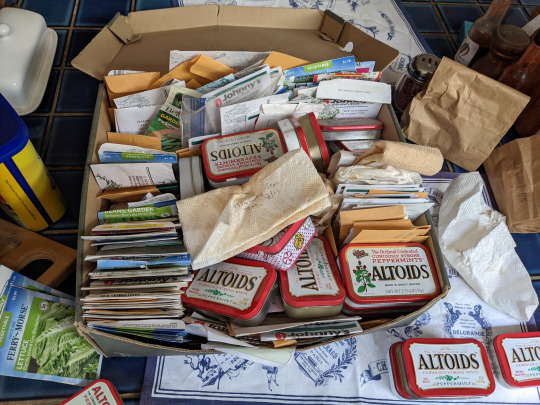
A new snapshot from https://sagesacre.com/2022/03/12/time-to-get-this-garden-started-2022/
Time to Get This Garden Started
My (poorly organized) box of vegetable and flower seeds for spring
Winter sucked, I hope spring is better
Whew, it’s been a rough winter. I can’t wait for it to be over. Usually by this time we’ve got a dozen or so different veggies started in the greenhouse in anticipation of transplanting outdoors in early April, but that’s not going to happen this year.
While it’s been very dry (thanks La Niña), temperatures have also swung crazy amounts. We had multiple weeks in January and February where the temperatures climbed well into the 80’s and 90’s in the day time and then dropped to below freezing overnight. (One day in February has a 93° high and a 28° low overnight!) Additionally, our typical last day of frost is in late February, but this year we’re still getting overnight freezes well into March.
For my unheated greenhouse, that’s just too much volatility to expect reliable germination or seedling growth. Actually, it was even too much for my milk carton mini-greenhouses as well. So, after the third round of frying and freezing seedling, I decided to hold off on any more attempts at getting an early start until we had a stretch of more moderate weather — which just happens to be beginning right now (at least according to the weather people).
So, embracing “the fourth time is the charm” principle, I’ve decided to try again with the hope of getting some of the seedlings transplanted into the garden by mid-April. It’s only about two weeks later than usual, so by planting shorter season varieties and goosing the seedlings with seed mats and humidity domes, I don’t think it’ll have too much impact on the late spring harvest.
This week I’m planting snow peas, spinach, cucumbers (pickling and slicer varieties), Cos lettuce, broccoli, marjoram, cilantro and basil. If the weather holds, next week we’ll get some beans, tomatoes, peppers and squash started as well.
Seeds for 2022 in planting trays
Fortunately, even though I’m behind on the main vegetable garden, the keyhole garden, is already planted with early season broccoli, onions, carrots, spinach and lettuce. Because it’s closer to the house and more sheltered from the weather, while it’s still not as mature as it was last year, it’s weeks ahead of the main garden.
#backyardgardening#californiagarden#eatwhatyougrow#ediblegarden#garden#gardenersofinstagram#gardening#gardentotable#greenthumb#growfood#growwhatyoueat#growyourfood#growyourown#growyourownfood#gyo#keyholegarden#kitchengarden#mybackyard#organicgardening#raisedbedgarden#sandiegogarden#spring 2022#vegetablegarden#veggiegarden#zone9#zone9garden
0 notes
Photo

A new snapshot from https://sagesacre.com/2022/02/03/early-start-on-spring/
Early Start on Spring
Using empty milk jugs to get spring vegetable seedlings started.
It’s middle of winter and at this time of year we get a lot of high pressure that squeezes over the mountains from the desert. That makes for warm, windy, dry days and cold, clear nights.
Outside temperatures will swing 30 degrees in just a few hours, going from freezing at 7AM to the upper 60’s by noon. Temperatures in my unheated greenhouse will swing an even broader range faster, going from the mid 20’s just after dawn to the high 80’s/low 90’s by late morning.
That’s fine for the succulents and cacti, but, even with tray warmers and humidity domes, it’s too much for vegetable seed starting.
As a result, I’ll let the greenhouse sit empty a few more weeks and get some early crops started using the old milk jug greenhouse method instead.
As you can see, they’re nothing but 1 gallon plastic milk jugs cut in half and filled with potting soil. Add some seeds, stick the top back on, tape the seam to keep the pieces together and viola!, a mini-greenhouse.
Better yet, these guys don’t even need much sun. It’s really about keeping the soil temperatures up so the seeds will germinate and establish strong roots. If you’ve got them indoors, a little indirect light is more than enough. If they’re outside (like mine), place them next to a wall or building.
Mine are on the west side of the storage shed where they only get a couple hours of sun in the late afternoon, but the shed continues to radiate heat, keeping the little greenhouses warmer than the air temperature well into the evening.
By the end of March, all these guys will be ready to move into the garden.
0 notes
Photo

A new snapshot from https://sagesacre.com/2022/01/20/rosy-fingered-dawn/
Rosy Fingered Dawn
Rosy-fingered dawn rising above the mountains and chasing away the night
After a week of clouds, we got a spectacular sunrise this morning. Eos, goddess of dawn, using her rosy-fingered powers to chase away the mists of night so her brother Helios can rise above the mountains to the east, make his daily journey across the sky and set into the ocean.
2 notes
·
View notes
Photo
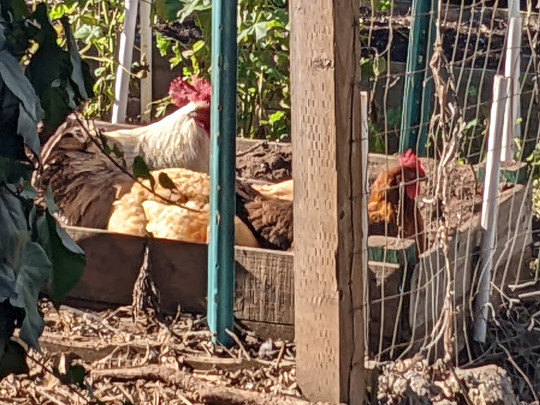
A new snapshot from https://sagesacre.com/2022/01/16/raised-bed-chickens/
Raised Bed Chickens
Our chickens taking a break for a dust bath after clearing the raised bed
In the winter we open the vegetable garden to the chickens and ducks to forage. We leave all of fall’s spent plants, dried stalks and overripe fruit in place and let the poultry do their work. By the time the Mid-March rolls around and we close the garden off for Spring planting, they will have dutifully nibbled, chopped, squashed, scratched, and cleaned all 1,600 square feet of garden leaving perfectly aerated and fertilized beds behind.
I swung the gates to the garden open yesterday. I took all of 10 minutes for the flock to, well, flock to the undiscovered country. Jonesy and his hens cleared the artichoke bed right away. Now they’re taking dust baths and adding nitrogen before they move on to the old squash beds.
#backyard chickens#backyard ducks#backyard flock#california garden#my garden#organic garden#organic gardener#organic gardening#raised bed garden#san diego garden#vegetable garden#winter garden#zone 9#zone 9 garden
0 notes
Photo
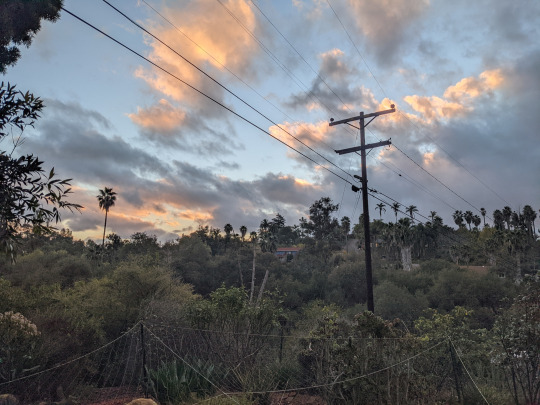
A new snapshot from https://sagesacre.com/2021/12/31/last-sunset-of-2021/
Last Sunset of 2021
Sunset in San Diego on December 31, 2021
The last sunset of 2021. Photo taken at 4:53PM about 45 miles north of San Diego looking west toward the Pacific Ocean which is just over the hills.
0 notes
Photo
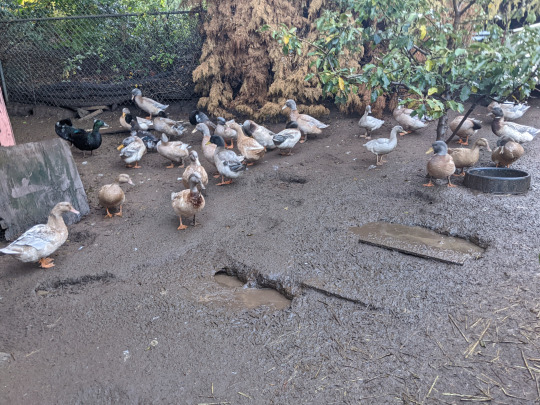
A new snapshot from https://sagesacre.com/2021/12/31/the-decisions-ducks-make/
The Decisions Ducks Make
The backyard flock of ducks prefers oozy mud to fresh grass
It’s been raining off and on for the past week. It began before Christmas and has been with us pretty much ever since. Not very San Diego at all.
The upside is all that water has given the acre a good drink and the west side is alive with young weeds and grasses. The chickens (plus Roger the rogue Guinea Fowl) are taking advantage of the soft soil for an all day grass and grub buffet.
I’m pretty sure the ducks would enjoy the combo almost as much, but I can’t coax them away from the east side, which is bare ground, well-shaded all day by a couple of oaks.
Those were the openings to ground squirrel burrows until the ducks turned them into small ponds.
You see, after a week of rain and water water pouring out of ground squirrel burrows upslope, this area is sloppier than a happy hog wallow. Three inches of mud and slime equals 20-odd ducks having the time of their lives.
0 notes
Photo

A new snapshot from https://sagesacre.com/2021/10/20/the-greenhouse-is-all-potential/
The Greenhouse is All Potential
The empty greenhouse on October 19, 2021
Most of the year my greenhouse is full of plants. Trees, vegetables, tropical and exotics, orphaned houseplants, cuttings in propagation, you name it. If it’s got roots, 9 months of the year there’s probably one in the greenhouse somewhere.
Three months of the year — roughly mid-July to mid-October — the greenhouse stands empty because it get so hot so fast that everything (even cactus) fries almost instantly. With it’s south and west exposures and the San Diego summer sun pounding down on it even with vents and doors wide open, fans on and 90% shade, it’s an oven.
So for three months of the year, the tropicals, exotics and orphaned houseplants live on the patio, the seedlings do their sprouting on the on the covered deck, and the greenhouse stands empty of everything but the pots and other stuff I store in there. By late September everything is covered with a layer of dirt and the whole thing looks neglected and sad.
But now that it’s mid-October and summer’s heat has subsided (37°F the other night!), it’s time for the tender plants to make their annual migration from the deck and patio back to the greenhouse’s warmer climate. It’s also time to propagate a few sage cuttings and get the next round of winter veggies started. And all of this requires the greenhouse to be cleaned, organized and made ship-shape for its incoming leafy residents.
So that’s what I’ll be doing this weekend.
Truthfully, it’s probably my favorite garden time of the year. Right now — before the sudden hard frosts, Pacific storms, rodent pests, and occasional rogue chicken — this year’s greenhouse season is (potentially) perfect.
#autumn#backyardgardening#californiagarden#greenhouse#greenhouse garden#greenhouse growing#mybackyard#plant potential#sandiegogarden#zone9#zone9garden
0 notes
Photo

A new snapshot from https://sagesacre.com/2021/10/13/sort-of-office-mates/
Sort of office mates

youtube
youtube
Working from home a lot of people get interrupted by dogs, kids, and maybe the occasional leaf blower. Me, I’ve got an entirely different problem outside my office window.
.fusion-body .fusion-builder-column-1width:100% !important;margin-top : 0px;margin-bottom : 0px;.fusion-builder-column-1 > .fusion-column-wrapper padding-top : 0px !important;padding-right : 0px !important;margin-right : 1.92%;padding-bottom : 0px !important;padding-left : 0px !important;margin-left : 1.92%;@media only screen and (max-width:1024px) .fusion-body .fusion-builder-column-1width:100% !important;.fusion-builder-column-1 > .fusion-column-wrapper margin-right : 1.92%;margin-left : 1.92%;@media only screen and (max-width:640px) .fusion-body .fusion-builder-column-1width:100% !important;.fusion-builder-column-1 > .fusion-column-wrapper margin-right : 1.92%;margin-left : 1.92%;
.fusion-body .fusion-flex-container.fusion-builder-row-2 padding-top : 0px;margin-top : 0px;padding-right : 0px;padding-bottom : 0px;margin-bottom : 0px;padding-left : 0px;
0 notes
Photo
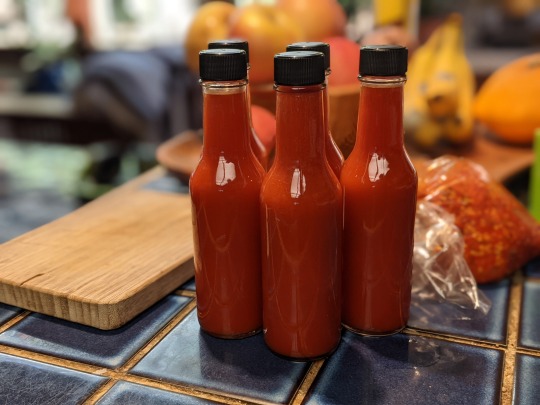
A new snapshot from https://sagesacre.com/2021/10/05/first-run-of-batch-21-fermented-hot-sauce/
First run of Batch 21 Fermented Hot Sauce
First round of hot sauce from batch 21. These peppers fermented only 4 weeks before bottling
While a lot of the garden veggies didn’t do all that well this year (more on that later), the Hidden Lake Hot peppers did just fine.
I started Batch 21 of my annual fermented hot sauce at the end of August, but rather than letting letting it all ferment for a full six months as I normally do, this year I’m pulling about half to bottle every few weeks and topping off the fermenter with fresh peppers.
Hot peppers after 4 weeks of fermentation
This is the first round which fermented for about four weeks before getting pureed, adding vinegar and cooking down to a sauce consistency.
My goal is to have a whole bunch of samples pulled from now until March (when I usually bottle) to see how the flavor profile of the hot sauce changes over time.
This first batch is spicy with lots of fresh, hot pepper taste and very little “funk” flavor or aroma from the fermentation. There isn’t much heat up front, but the finish kicks you in the tonsils.
Related Posts
.fusion-blog-shortcode-1 .fusion-blog-layout-grid .fusion-post-gridpadding:20px;.fusion-blog-shortcode-1 .fusion-posts-containermargin-left: -20px !important; margin-right:-20px !important;
First run of Batch 21 Fermented Hot Sauce
Projects, Recipes
First run of Batch 21 Fermented Hot Sauce
I am continuously fermenting the hot peppers, adding fresh peppers every week, and pulling half after 4 week's time to turn into hot sauce. This is round 1.
Batch 21 Begins
Garden, Projects
Batch 21 Begins
Batch 21 of my fermented hot sauce begins! This year it's a 100% cayenne/Thai pepper hybrid. We start the ferment today with 12 ounces of fresh peppers in brine
Video: Batch 20 Hot Sauce Bottled and Ready
Projects, Recipes
Video: Batch 20 Hot Sauce Bottled and Ready
The 20th edition of my slow ferment hot sauce. It's funky, fruity with a medium heat on the back. BBQ worthy for sure! See how to make your own in the video.
Video: Hot Sauce Progress – Entry 6
Garden, Projects
Video: Hot Sauce Progress – Entry 6
It's been a little more than six weeks since we began the fermentation on Batch 20 of my hot sauce. Today I'm popping open the fermenter to see how it's going and give the peppers a stir to keep thing moving.
Batch 20 Hot Sauce Progress – Entry 5
Garden, Projects
Batch 20 Hot Sauce Progress – Entry 5
Batch 20 of the fermented hot sauce hit 5 gallons of fresh peppers 8 weeks early, so I'm bumping up to 10 gallons by splitting peppers between 2 fermenters. As for what I'm going to do with 10 gallons of finished hot sauce next spring, I have no idea.
Batch 20 Hot Sauce – Entry 4
Garden, Projects
Batch 20 Hot Sauce – Entry 4
Just put week 4's fresh peppers into the fermenter for Batch 20 of the fermented hot sauce. With the brine, looks like we're about 2/3rds of the way to getting a full 5 gallons before we send it off to spend the winter aging with oak
12Next
.fusion-body .fusion-builder-column-0width:100% !important;margin-top : 0px;margin-bottom : 0px;.fusion-builder-column-0 > .fusion-column-wrapper padding-top : 0px !important;padding-right : 0px !important;margin-right : 1.92%;padding-bottom : 0px !important;padding-left : 0px !important;margin-left : 1.92%;@media only screen and (max-width:1024px) .fusion-body .fusion-builder-column-0width:100% !important;.fusion-builder-column-0 > .fusion-column-wrapper margin-right : 1.92%;margin-left : 1.92%;@media only screen and (max-width:640px) .fusion-body .fusion-builder-column-0width:100% !important;.fusion-builder-column-0 > .fusion-column-wrapper margin-right : 1.92%;margin-left : 1.92%;
.fusion-body .fusion-flex-container.fusion-builder-row-1 padding-top : 0px;margin-top : 0px;padding-right : 0px;padding-bottom : 0px;margin-bottom : 0px;padding-left : 0px;
#aged hot sauce#batch 21#cayenne pepper#fermented food#fermented hot sauce#hot peppers#hot sauce#september#thai pepper
0 notes
Photo
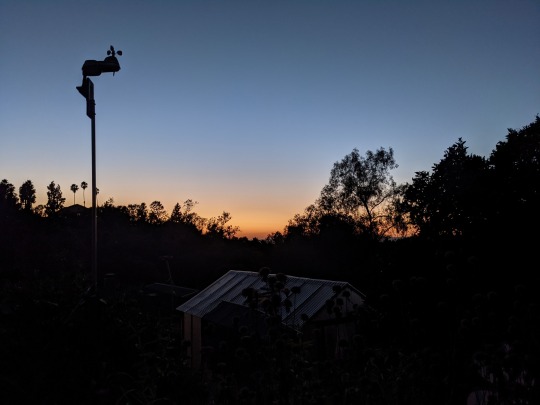
A new snapshot from https://sagesacre.com/2021/10/05/the-last-summer-sunset-of-2021/
The Last Summer Sunset of 2021

I snapped this shot of the last sunset of the summer right at twilight (7:11PM).
While it was a warm summer, it was substantially cooler on average than previous years. The hottest day, coincidentally was today (September 21) when temps peaked at 98°. By contrast, the summer of 2020 peaked on September 6th at 110°
Interestingly, summer isn’t usually the hottest time of year hear. That honor goes to early autumn. Last year we hit 101° on October 1. In 2019 we hit that same temperature on October 24.
Both of those are nothing compared to 2017, however. The October of that year saw us hit 100°+ five times between October 15th and 25th, with the 24th making our all time high of 112°F
0 notes
Photo

A new snapshot from https://sagesacre.com/2021/09/16/ducks-of-summer/
Ducks of Summer
Just a couple of days before summer began one of our ducks emerged from the bushes with seven new babies.
Sadly, one duckling didn’t make it (a Cooper’s Hawk got it). But the rest, 5 boys and a girl, grew up to be fine, full-fledged backyard birds.
They still stick together and have now established their own territory in an area behind the chicken coop and under the fig tree which is conveniently raining ripe fruit for them to snack on.
Hard to believe that these good looking fellows were nothing but yellow puffs just 90 days ago.
.fusion-image-before-after-2 .fusion-image-before-after-handle border-color:#ffffff;.fusion-image-before-after-2 .fusion-image-before-after-left-arrow border-right-color:#ffffff;.fusion-image-before-after-2 .fusion-image-before-after-right-arrow border-left-color:#ffffff;.fusion-image-before-after-2 .fusion-image-before-after-handle::after background:#ffffff;box-shadow: 0 3px 0 #ffffff, 0 0 12px rgba(51,51,51,.5);.fusion-image-before-after-2 .fusion-image-before-after-handle::before background:#ffffff;box-shadow: 0 3px 0 #ffffff, 0 0 12px rgba(51,51,51,.5);.fusion-image-before-after-2 .fusion-image-before-after-handle background:rgba(255,255,255,0);.fusion-image-before-after-2 .fusion-image-before-after-before-label:before,.fusion-image-before-after-2 .fusion-image-before-after-after-label:beforefont-size:14px;.fusion-image-before-after-2 .fusion-image-before-after-before-label:before,.fusion-image-before-after-2 .fusion-image-before-after-after-label:beforecolor:#ffffff;background:rgba(255,255,255,0.15);
Here’s a short video of them at 2 weeks challenging the chickens for a share of the zucchini.
.fusion-body .fusion-builder-column-1width:100% !important;margin-top : 0px;margin-bottom : 0px;.fusion-builder-column-1 > .fusion-column-wrapper padding-top : 0px !important;padding-right : 0px !important;margin-right : 1.92%;padding-bottom : 0px !important;padding-left : 0px !important;margin-left : 1.92%;@media only screen and (max-width:1024px) .fusion-body .fusion-builder-column-1width:100% !important;.fusion-builder-column-1 > .fusion-column-wrapper margin-right : 1.92%;margin-left : 1.92%;@media only screen and (max-width:640px) .fusion-body .fusion-builder-column-1width:100% !important;.fusion-builder-column-1 > .fusion-column-wrapper margin-right : 1.92%;margin-left : 1.92%;
.fusion-body .fusion-flex-container.fusion-builder-row-2 padding-top : 0px;margin-top : 0px;padding-right : 0px;padding-bottom : 0px;margin-bottom : 0px;padding-left : 0px;
1 note
·
View note